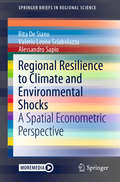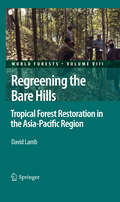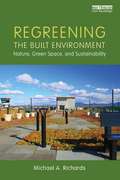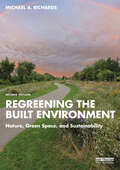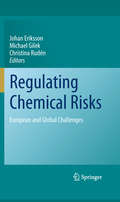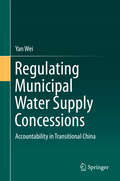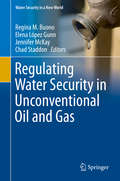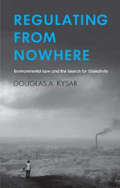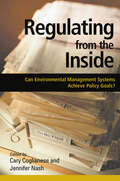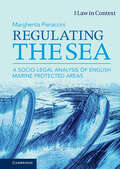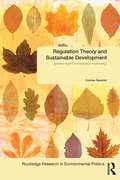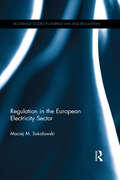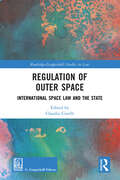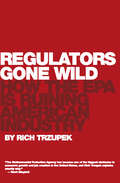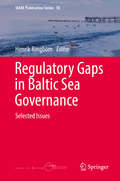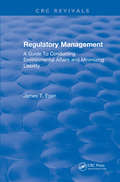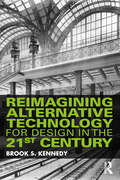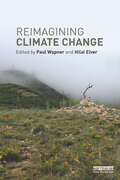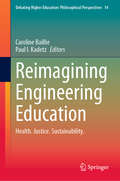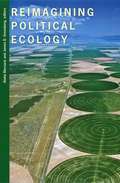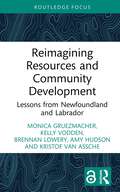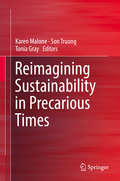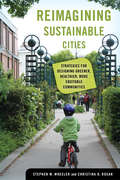- Table View
- List View
Regional Political Ecologies and Environmental Conflicts in India (Routledge Focus on Environment and Sustainability)
by Sarmistha Pattanaik and Amrita SenThis book focuses on the regional political ecologies (RPEs) of environmental conflicts in India. It explores broadly, landscape-based analyses of political, economic and social issues, which impact environmental changes, challenges and conflicts at local and micro-local levels. The chapters in this volume examine the intervention of different stakeholders in the management of various regional ecological landscapes in India, including forests, rivers, canals, creeks and wetlands. The volume is an interdisciplinary endeavour, weaving together contextual narratives through a combination of approaches from sociology, anthropology, geography, political studies and environmental history. Using such core approaches, the book studies the place-based dynamisms within the regional environmental conflicts in the selected conservation landscapes. It provides empirical reflections on transboundary issues, rural-urban transitions, middle-class environmentalism, identity conflicts, decentralized natural resource management and the role of political institutions. Regional Political Ecologies and Environmental Conflicts in India will be of great interest to students and scholars of Political Ecology and South Asian Environmental Studies.
Regional Resilience to Climate and Environmental Shocks: A Spatial Econometric Perspective (SpringerBriefs in Regional Science)
by Rita De Siano Valerio Leone Sciabolazza Alessandro SapioThe book illustrates the use of spatial econometric models to analyze the economic resilience of regions to climate-related shocks. Although climate change is a global externality, climate anomalies can trigger locally disruptive shocks, whose adverse effects on economic growth are transmitted through neighbouring relationships (based on geography, trade, or technological bonds). After laying out the theoretical case for spatial analysis in the study of economic resilience, the book introduces spatial econometric models, their estimation and testing procedures, as well as applications of spatial econometrics in various domains. It then reviews the current literature on the role of space in the propagation of climate shocks, and discusses how adaptation and mitigation policies can leverage spatial dependencies, with a special focus on renewable energy technologies and agricultural productivity. It appeals to scholars of regional and spatial sciences and econometrics as well as those interested in the spatial effects of climate and environmental shocks.
Regreening the Bare Hills
by David LambIn Regreening the Bare Hills: Tropical Forest Restoration in the Asia-Pacific Region, David Lamb explores how reforestation might be carried out both to conserve biological diversity and to improve the livelihoods of the rural poor. While both issues have attracted considerable attention in recent years, this book takes a significant step, by integrating ecological and silvicultural knowledge within the context of the social and economic issues that can determine the success or failure of tropical forest landscape restoration. Describing new approaches to the reforestation of degraded lands in the Asia-Pacific tropics, the book reviews current approaches to reforestation throughout the region, paying particular attention to those which incorporate native species - including in multi-species plantations. It presents case studies from across the Asia-Pacific region and discusses how the silvicultural methods needed to manage these 'new' plantations will differ from conventional methods. It also explores how reforestation might be made more attractive to smallholders and how trade-offs between production and conservation are most easily made at a landscape scale. The book concludes with a discussion of how future forest restoration may be affected by some current ecological and socio-economic trends now underway. The book represents a valuable resource for reforestation managers and policy makers wishing to promote these new silvicultural approaches, as well as for conservationists, development experts and researchers with an interest in forest restoration. Combining a theoretical-research perspective with practical aspects of restoration, the book will be equally valuable to practitioners and academics, while the lessons drawn from these discussions will have relevance elsewhere throughout the tropics.
Regreening the Built Environment: Nature, Green Space, and Sustainability
by Michael A RichardsRegreening the Built Environment examines the relationship between the built environment and nature and demonstrates how rethinking the role and design of infrastructure can environmentally, economically, and socially sustain the earth. In the past, infrastructure and green or park spaces have been regarded as two opposing factors and placed in conflict with one another through irresponsible patterns of development. This book attempts to change this paradigm and create a new notion that greenspace, parks, and infrastructure can indeed be one in the same. The case studies will demonstrate how existing "gray" infrastructure can be retrofitted with green infrastructure and low impact development techniques. It is quite plausible that a building can be designed that actually creates greenspace or generates energy; likewise, a roadway can be a park, an alley can be a wildlife corridor, and a parking surface can be a garden. In addition to examining sustainability in the near future, the book also explores such alternatives in the distant and very distant future, questioning the notion of sustainability in the event of an earth-altering, cataclysmic disaster. The strategies presented in this book aim to stimulate discussions within the design profession and will be of great interest to students and practitioners of environmental studies, architecture, and urban design.
Regreening the Built Environment: Nature, Green Space, and Sustainability
by Michael A. RichardsNow in its second volume, Regreening the Built Environment provides an overview of physical and social environmental challenges that the planet is facing and presents solutions that restore ecological processes, reclaim open space, foster social equity, and facilitate a green economy.Healing the planet requires a combination of strategies networked across multiple scales of development, including buildings, sites, communities, and regions. Case studies from a range of locations in the United States, Denmark, Vietnam, Germany, South Korea, Switzerland, France, and the United Kingdom, among others, demonstrate how existing gray infrastructure can be retrofitted with green infrastructure and low-impact development techniques. From this, the author shows how a building can be designed that creates greenspace or generates energy; likewise, a roadway can be a parkway, an alley can be a wildlife corridor, and a parking surface can be a garden. This new edition also includes case studies that have successfully reconnected communities that were fragmented by unjust planning practices and irresponsible patterns of development, resilient design solutions in response to natural disasters, passive design strategies that can make interior spaces more efficient and healthier, and expanded discussions on capturing carbon, renewable energy, agriculture, waste, public transit, and adaptive reuse, including innovative ideas on how to reimagine the shopping mall in the era of e-commerce.The strategies presented in this book will stimulate discussions within the design profession and will be of great interest to students and practitioners of environmental studies, architecture, landscape architecture, and urban design.
Regulating Chemical Risks
by Michael Gilek Christina Rudén Johan ErikssonThis important contribution to the scientific understanding of chemical risk regulation offers a coherent, comprehensive and updated multidisciplinary analysis, written by leading experts in toxicology, ecotoxicology, risk analysis, media and communication, law, and political science.
Regulating Municipal Water Supply Concessions
by Yan WeiThis book discusses the recently introduced concession policy, which is also known as PPP worldwide, on municipal utilities policy in China. In this context, critics have claimed that there is a gap in accountability with regard to concessions. The author utilizes interdisciplinary methods and comparative studies, taking into account the situation in the EU and US to analyze the accountability gap some feel will be created when the policy is implemented. Taking water sector concessions as the subject of discussion, the author distinguishes between three types of accountability: traditional bureaucratic accountability, legal accountability and public accountability. By systematically analyzing the essential problems involved, the book attempts to achieve a better understanding of concession and its application in the context of public utilities and finds that the alleged accountability gap is attributed to traditional bureaucratic accountability in China and the concession system per se.
Regulating Water Security in Unconventional Oil and Gas (Water Security in a New World)
by Chad Staddon Regina M. Buono Elena López Gunn Jennifer McKayThis book addresses the need for deeper understanding of regulatory and policy regimes around the world in relation to the use of water for the production of ‘unconventional’ hydrocarbons, including shale gas, coal bed methane and tight oil, through hydraulic fracturing. Legal, policy, political and regulatory issues surrounding the use of water for hydraulic fracturing are present at every stage of operations. Operators and regulators must understand the legal, political and hydrological contexts of their surroundings, procure water for use in the fracturing and extraction processes, gain community cooperation or confront social resistance around water, collect flow back and produced water, and dispose of these wastewaters safely. By analysing and comparing different approaches to these issues from around the globe, this volume gleans insights into how policy, best practices and regulation may be developed to advance the interests of all stakeholders. While it is not always possible to easily transfer ‘good practice’ from one place to another, there is value in examining and understanding the components of different legal and regulatory regimes, as these may assist in the development of better regulatory law and policy for the rapidly growing unconventional energy sector.The book takes an interdisciplinary approach and includes chapters looking at water-energy nexus security in general, along with issue-focused and geographically-focused case studies written by scholars from around the world.Chapter topics, organized in conjunction with the stage of the shale gas production process upon which they touch, include the implications of hydraulic fracturing for agriculture, municipalities, and other stakeholders competing for water supplies; public opinion regarding use of water for hydraulic fracturing; potential conflicts between hydraulic fracturing and water as a human right; prevention of induced seismic activity, and the disposal or recycling of produced water. Several chapters also discuss implications of unconventional energy production for indigenous communities, particularly as regards sustainable water management. This volume will be of interest to scholars and students of energy and water, regulators and policymakers and operators interested in ensuring that they align with emergent best global practice.
Regulating from Nowhere: Environmental Law and the Search for Objectivity
by Douglas A. KysarDrawing insight from a diverse array of sources -- including moral philosophy, political theory, cognitive psychology, ecology, and science and technology studies -- Douglas Kysar offers a new theoretical basis for understanding environmental law and policy. He exposes a critical flaw in the dominant policy paradigm of risk assessment and cost-benefit analysis, which asks policymakers to, in essence, "regulate from nowhere. " As Kysar shows, such an objectivist stance fails to adequately motivate ethical engagement with the most pressing and challenging aspects of environmental law and policy, which concern how we relate to future generations, foreign nations, and other forms of life. Indeed, world governments struggle to address climate change and other pressing environmental issues in large part because dominant methods of policy analysis obscure the central reasons for acting to ensure environmental sustainability. To compensate for these shortcomings, Kysar first offers a novel defense of the precautionary principle and other commonly misunderstood features of environmental law and policy. He then concludes by advocating a movement toward environmental constitutionalism in which the ability of life to flourish is always regarded as a luxury wecanafford.
Regulating from the Inside: Can Environmental Management Systems Achieve Policy Goals (Rff Press Ser.)
by Cary CoglianeseEnvironmental Management Systems (EMSs) offer an approach to regulatory policy that lies somewhere between free-market and traditional command-and-control methods. Worldwide, hundreds of thousands of private firms have adopted or are considering adopting these internally managed systems for improving environmental performance. In the United States, the Environmental Protection Agency has established a special recognition for firms that adopt EMSs. Already, numerous state agencies have proposed or adopted 'green-tier systems' that allow firms with EMSs to be exempted from otherwise applicable requirements. Yet while private- and public-sector interest in EMSs is booming, limited empirical evidence is available about the efficacy of EMSs. To close the gap between advocacy and analysis, Regulating from the Inside brings together cutting-edge work of leading scholars, providing the most comprehensive analysis to date of environmental management systems. Intended to frame the future policy and the research agenda about EMSs, the discussions are organized around two critical questions: How have EMSs worked in firms that have already adopted them? What potential and limitations do they have as policy tools in the future? Addressing the arguments of both advocates and skeptics, the chapters examine why firms adopt EMSs; how firms implement EMSs; how EMSs answer concerns about fairness, corporate social responsibility, and sustainability; and what kind of impact EMSs may have on the global economy.
Regulating the Sea: A Socio-Legal Analysis of English Marine Protected Areas (Law in Context)
by Margherita PieracciniThis book is the first ever written on English marine conservation regulation from a socio-legal perspective. The monograph presents an in-depth analysis of key aspects of Marine Protected Areas regulation in England, offering the reader access to an under-investigated field. Such regulatory mapping is complemented by an interdisciplinary treatment of the subject exploring the relationship between people and marine parks through central themes in environmental social sciences and regulatory theory, namely space, rationalisation, democracy and adaptation. Thus, the book is of interest to environmental lawyers and regulatory scholars but also to human geographers, environmental sociologists and political scientists. As the book provides critical reflections on current legal and regulatory structures, it contains valuable insights for policymakers and regulators. The book has a strong methodological basis drawing on in-depth desk-based research, complemented by primary qualitative research, conducted over a number of years.
Regulation Theory and Sustainable Development: Business Leaders and Ecological Modernisation (Environmental Politics)
by Corinne GendronThis book argues that current economist theories do not take into account the socially constructed nature of the debate surrounding the environment and environmental policy. It examines whether proposed economic solutions to environmental policy are, in fact, viable in practice. The book demonstrates that social conflicts cause policy compromises, which shape the economic system of a post-industrial ecological society. The author offers an innovative socio-economic theory of environmental politics, which illuminates the transformation dynamics brought about by the ecological crisis. Regulation Theory and Sustainable Development will be of interest to students and scholars of environmental politics, policy and governance.
Regulation in the European Electricity Sector (Routledge Research in Energy Law and Regulation)
by Maciej M SokołowskiSince the very beginning of European integration, electricity has been within the legal sphere of the EU. Much of this is found within the binding European acts making up the framework of the Energy Packages. The established legal institutions have had a significant impact on the shape of the energy market in Europe. Nevertheless, the European energy market still seems to be developing, as demonstrated by the current lively discussion about the state of the Energy Union. Regulation in the European Electricity Sector delves into European energy law and reflects on some of the primary issues related to the public legal impact on the European energy sector. The book offers a brief explanation of the background operation of the electricity sector, as well as liberalisation within the area, and traces the evolution of the EU’s approach towards the issue of public law regulation within the electricity sector. Finally, the book presents an analysis of European and national laws, considering their interpretation, and explores the future of public law regulation. Aimed at giving the reader a deep insight into a nature of the state’s presence in the power sector, this book will be of great interest to students and scholars of EU energy law and policy.
Regulation of Biological Control Agents
by Ralf-Udo EhlersThis book presents a comprehensive compilation of registration requirements necessary for authorisation of biological control agents (viruses, bacteria, fungi, active substances of natural origin and semiochemicals) in OECD countries. It also reviews data requirements for invertebrate agents (insect, mites and nematodes) and provides proposals for harmonisation of the regulation process and guidelines for completion of application forms. Based on results of the EU REBECA Policy Support Action, which gathered experts from academia, regulation authorities and industry, risks and benefits of the specific agents were reviewed and proposals for a more balanced registration process elaborated, including recommendations for acceleration of the authorisation process and discussions on trade-off effects and policy impacts. All these aspects are covered in detail in this book, which points the way forward for enhanced utilisation of biological control agents.
Regulation of Outer Space: International Space Law and the State (Routledge-Giappichelli Studies in Law)
by Marco FerrazzaniThis edited book focuses on how States should regulate activities in space and explores strategies to advance State responsible behaviour to ensure sustainable use and effective protection of outer space for peaceful purposes. The time seems ripe to bring international law into the space sustainability discourse. The concept of sustainable development was conceptualized by the 1987 Brundtland Report, Our Common Future. Today, as then, the overlap between the security, environmental and economic dimensions, including in terms of intra/inter-generational equity, is reflected within the current ‘new space’ era that is now ‘our common future’. This edited book collects original theoretical and empirical contributions. It contributes to unpack the international outer space regulatory framework in the light of current trends and pressing challenges. This offers a unique perspective and guidance thus empowering regulatory strategies for stakeholders and end-users such as scholars, policy-makers, industry and society.
Regulators Gone Wild
by Rich TrzupekRich Trzupek has spent over 25 years engaged in combat with the environmental movement on the front lines, helping America's industrial sector defend itself against the increasingly aggressive tactics that environmental advocacy groups and their allies in the Environmental Protection Agency employ. In Regulators Gone Wild Trzupek lays out the inside story that describes the way the green/big government alliance has combined to stifle American productivity and hamstring American innovation, not by design, but as the inevitable consequence of pursuing a utopian vision of environmental purity that can never, ever be realized.As a respected scientist and consultant, Rich Trzupek has been employed by some of America's largest corporations and by some of its smallest, most innovative entrepreneurs. Those experiences have provided him with a unique perspective. While many of his colleagues in the industrial consulting community only consider the short-term profit opportunities that an overly aggressive EPA provides them, Trzupek takes a longer view. If the EPA continues to hamstring America's ability to create wealth, everyone loses.When it comes to today's environmental issues, most of the public's attention is focused on the issue of "climate change" and initiatives to reduce fossil fuel use and greenhouse gas emissions. As a climate change skeptic, Trzupek argues against these measures, but he sees the rise of this issue as another inevitable step in a progression that spans four decades during which the green movement has continually sought new ways to control industry and the EPA has always happily obliged them. Attempts to restrict America's use of cheap, plentiful coal and stop oil exploration are just the latest examples of regulators gone wild.
Regulatory Gaps in Baltic Sea Governance: Selected Issues (Mare Publication Ser. #18)
by Henrik RingbomThe focus of this publication is the uniqueness of the Baltic Sea from a legal perspective, and the regulatory voids that result from the multiple layers of regulation this area is subjected to: up to six layers of regulation (general international law, regional conventions, EU law, national laws, local and municipal rules plus a whole range of non-binding norms and other 'soft law' arrangements) act in parallel. However, a large number of rules or regulatory layers does not in itself ensure effectiveness or consistency. When the regulatory landscape is approached from the point of view of individual substantive topics, it is apparent that the norms of different regulatory layers entail both overlaps, gaps and uncertainties, differently for each topic. This publication addresses a selection of topics that are decidedly international in nature, but for which current international and EU rules include important gaps or uncertainties.In addition to presenting a set of legal analyses of topical issues for the region, which in itself is a meritorious objective in view of the relative scarcity of legal studies with a focus on the Baltic Sea, the publication also seeks to analyze the regulatory 'anatomy' of the selected issues in more detail. Through the legal analyses the chapters explore how regulatory gaps are formed, how they are filled, how the rules of the different layers work together and interact with each other in the selected areas. Accordingly, the secondary ambition is to explore, through the chapters, whether more general conclusions can be drawn about the nature of the regulatory gaps and multi-layerism in order to produce a better understanding of how regulations on multiple levels operate in practice.
Regulatory Management: A Guide To Conducting Environmental Affairs and Minimizing Liability
by James T. EganRegulatory Management: A Guide to Conducting Environmental Affairs and Minimizing Liability emphasizes the importance of establishing a proactive approach to permit negotiation and compliance. This book is an important guide to conducting environmental affairs and minimizing liability. This book is a "must have" book for anyone responsible for regulatory compliance/management - private industry, environmental consultants, university officials, environmental engineers, environmental attorneys.Public and political concern about the environment has grown at a phenomenal rate over the last several years. Not since the early 1970s has there been such emphasis on reducing pollution. Congress and the Environmental Protection Agency have responded by enacting tough new legislation and increasing enforcement activities. Industry, utilities, and other entities that continue to discharge must invest millions of dollars in advanced waste treatment or face heavy fines or liability.In 10 detailed chapters, the author explains how to establish cooperative partnerships with politicians and regulators, create solution-oriented strategies using legal and technical permit insights, allocate resources to provide maximum environmental protection at minimum cost, reduce accidents and errors through training programs and procedure documentation, and influence the regulatory process to win practical and achievable permit limits. The book also shows you how to increase public credibility and manage the media, track treatment operations to provide a strong defense in the event of litigation, and keep up with new regulations and new technologies. The book is designed to help its readers set into motion the processes that will develop real solutions to environmental/regulatory challenges and will assist in developing an active and proactive management style that focuses on results as it minimizes liability.
Reimagining Alternative Technology for Design in the 21st Century
by Brook S. KennedyReimagining Alternative Technology for Design in the 21st Century presents a new approach to design that harnesses still-valuable alternative, traditional and abandoned technologies alongside the creation of new ones to address contemporary global problems. It focuses on design opportunities that reduce energy and material consumption to tackle issues such as climate change and pollution in industrialized economies. The book takes the reader on a journey surveying different facets of human activity to identify underused and discarded technologies that could be indispensable today. It critically addresses newer approaches to design and technology by comparing them to existing alternatives, unpacking examples including air conditioning with smart thermostats, electric lighting, durable reusable products, domestic maintenance tools and methods of transportation. Written for practicing designers and students in industrial design, architecture, sustainable design and human-centered design, this book provides new ideas and tools for creating more useful, energy-and-resource-efficient product designs and systems.
Reimagining Climate Change (Routledge Advances in Climate Change Research)
by Paul Wapner Hilal ElverResponding to climate change has become an industry. Governments, corporations, activist groups and others now devote billions of dollars to mitigation and adaptation, and their efforts represent one of the most significant policy measures ever dedicated to a global challenge. Despite its laudatory intent, the response industry, or ‘Climate Inc.’, is failing. Reimagining Climate Change questions established categories, routines, and practices that presently constitute accepted solutions to tackling climate change and offers alternative routes forward. It does so by unleashing the political imagination. The chapters grasp the larger arc of collective experience, interpret its meaning for the choices we face, and creatively visualize alternative trajectories that can help us cognitively and emotionally enter into alternative climate futures. They probe the meaning and effectiveness of climate protection ‘from below’—forms of community and practice that are emerging in various locales around the world and that hold promise for greater collective resonance. They also question climate protection "from above" in the form of industrial and modernist orientations and examine large-scale agribusinesses, as well as criticize the concept of resilience as it is presently being promoted as a response to climate change. This book will be of great interest to students and scholars of climate change, global environmental politics, and environmental studies in general, as well as climate change activists.
Reimagining Engineering Education: Health. Justice. Sustainability. (Debating Higher Education: Philosophical Perspectives #14)
by Caroline Baillie Paul I. KadetzThis book considers a radical change to engineering education. It argues for a reexamination of the traditional way in which engineering students are educated in disciplinary silos and how, instead, we might re-imagine their professional education to more appropriately prepare students to design innovative solutions to increasingly complex global challenges. It poses the question: “How can engineers think outside the engineers’ box?". A box that has over generations rendered engineers to be unquestioning servants of the socio-political systems in which they function. The book introduces a unique framework and language for engineering education which considers both the problems of the past and present, and the potential solutions offered for the future. By reaching out beyond the bounds of traditional knowledge and thought collectives, this book will also offer a pathway for other professional education programs to explore.
Reimagining Political Ecology
by James B. Greenberg Aletta BiersackReimagining Political Ecology is a state-of-the-art collection of ethnographies grounded in political ecology. When political ecology first emerged as a distinct field in the early 1970s, it was rooted in the neo-Marxism of world system theory. This collection showcases second-generation political ecology, which retains the Marxist interest in capitalism as a global structure but which is also heavily influenced by poststructuralism, feminism, practice theory, and cultural studies. As these essays illustrate, contemporary political ecology moves beyond binary thinking, focusing instead on the interchanges between nature and culture, the symbolic and the material, and the local and the global. Aletta Biersack's introduction takes stock of where political ecology has been, assesses the field's strengths, and sets forth a bold research agenda for the future. Two essays offer wide-ranging critiques of modernist ecology, with its artificial dichotomy between nature and culture, faith in the scientific management of nature, and related tendency to dismiss local knowledge. The remaining eight essays are case studies of particular constructions and appropriations of nature and the complex politics that come into play regionally, nationally, and internationally when nature is brought within the human sphere. Written by some of the leading thinkers in environmental anthropology, these rich ethnographies are based in locales around the world: in Belize, Papua New Guinea, the Gulf of California, Iceland, Finland, the Peruvian Amazon, Malaysia, and Indonesia. Collectively, they demonstrate that political ecology speaks to concerns shared by geographers, sociologists, political scientists, historians, and anthropologists alike. And they model the kind of work that this volume identifies as the future of political ecology: place-based "ethnographies of nature" keenly attuned to the conjunctural effects of globalization. Contributors. Eeva Berglund, Aletta Biersack, J. Peter Brosius, Michael R. Dove, James B. Greenberg, Sren Hvalkof, J. Stephen Lansing, Gsli Plsson, Joel Robbins, Vernon L. Scarborough, John W. Schoenfelder, Richard Wilk
Reimagining Resources and Community Development: Lessons from Newfoundland and Labrador (Earthscan Studies in Natural Resource Management)
by Kelly Vodden Kristof Van Assche Monica Gruezmacher Brennan Lowery Amy HudsonThis book analyzes the experiences of communities facing major challenges relating to resource dependency and community sustainability, drawing on specific examples from the Canadian province of Newfoundland and Labrador. It offers a methodology of self-analysis for communities facing similar challenges, inspired by the ups and downs, local strategies for self-analysis, and collaborative work toward new futures in this Canadian province.Life in hundreds of small coastal settlements revolved around the cod fishery, until the fishery was no more viable. Communities have had to rethink their strengths, reconsider their assets, and imagine potential futures in the wake of events such as colonization and the collapse of the fishing industry. Their experiences are relevant for other parts of the world where formerly central resources are depleted or lose their value, and communities face the need for transition. The capacity to imagine different futures is rooted in the ability to critically consider strengths and weaknesses alike. The authors skillfully dissect and illuminate the conditions that can enable the reconsideration of local assets and narratives, toward a more sustainable future. The variety of these conditions, ranging from social memory to public debate, policy tools and institutional capacity, decision arenas, paths for participation, and distributed strategic leadership, are laid out clearly and illustrated vividly through vignettes written by individuals who participated in the events described. This book culminates in a flexible yet clearly structured method of self-analysis, useful for communities interested in rethinking their strengths and working toward new futures.This book will appeal to students, scholars, and professionals interested in community development and redevelopment and offers a new understanding of the mechanics of local and regional resilience
Reimagining Sustainability in Precarious Times
by Karen Malone Son Truong Tonia GrayThis book reflects the considerable appeal of the Anthropocene and the way it stimulates new discussions and ideas for reimagining sustainability and its place in education in these precarious times. The authors explore these new imaginings for sustainability using varying theoretical perspectives in order to consider innovative ways of engaging with concepts that are now influencing the field of sustainability and education. Through their theoretical analysis, research and field work, the authors explore novel approaches to designing sustainability and sustainability education. These approaches, although diverse in focus, all highlight the complex interdependencies of the human and more-than-human world, and by unpacking binaries such as human/nature, nature/culture, subject/object and de-centring the human expose the complexities of an entangled human-nature relation that are shaping our understanding of sustainability. These messy relations challenge the well-versed mantras of anthropocentric exceptionalism in sustainability and sustainability education and offer new questions rather than answers for researchers, educators, and practitioners to explore. As working with new theoretical lenses is not always easy, this book also highlights the authors' methods for approaching these ideas and imaginings.
Reimagining Sustainable Cities: Strategies for Designing Greener, Healthier, More Equitable Communities
by Stephen M. WheelerA cutting-edge, solutions-oriented analysis of how we can reimagine cities around the world to build sustainable futures. What would it take to make urban places greener, more affordable, more equitable, and healthier for everyone? In recent years, cities have stepped up efforts to address climate and sustainability crises. But progress has not been fast enough or gone deep enough. If communities are to thrive in the future, we need to quickly imagine and implement an entirely new approach to urban development: one that is centered on equity and rethinks social, political, and economic systems as well as urban designs. With attention to this need for structural change, Reimagining Sustainable Cities advocates for a community-informed model of racially, economically, and socially just cities and regions. The book aims to rethink urban sustainability for a new era. In Reimagining Sustainable Cities, Stephen M. Wheeler and Christina D. Rosan ask big-picture questions of interest to readers worldwide: How do we get to carbon neutrality? How do we adapt to a climate-changed world? How can we create affordable, inclusive, and equitable cities? While many books dwell on the analysis of problems, Reimagining Sustainable Cities prioritizes solutions-oriented thinking—surveying historical trends, providing examples of constructive action worldwide, and outlining alternative problem-solving strategies. Wheeler and Rosan use a social ecology lens and draw perspectives from multiple disciplines. Positive, readable, and constructive in tone, Reimagining Sustainable Cities identifies actions ranging from urban design to institutional restructuring that can bring about fundamental change and prepare us for the challenges ahead.

